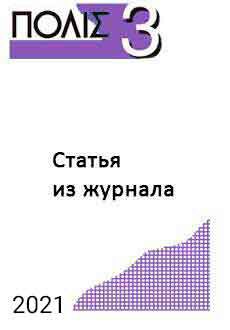Online shop of "Polis. Political Studies" Journal
We in the world, the world in us
Malinova O.Yu. Amending the Russian Constitution as Symbolic Politics: 1993-2020. – Polis. Political Studies. 2021. No. 3. P. 17-37. (In Russ.).
150 руб.
Constitutions are not simply political and legal documents; they are also complex political symbols that convey a manifold content and invite various interpretations. This article provides a review of the approaches to political symbolical analysis of constitutions. After this more general view, the author focuses on the symbolic competition of interpretations and explores the discussions about amending the Russian Constitution that took place from 1993 to 2020. The research is based on publications by official websites and media. The author demonstrates that the political crisis of 1993, which resulted in adoption of “Yeltsin’s” Constitution, played a formative role in shaping the identities of political forces that consolidated in the 1990s. The groups occupying different positions in the political spectrum included different meanings in the Constitution. They considered amendments not just as a tool for changing rules, but also as a vehicle for their desired values. Comparing the amendments adopted in 2020 reveals their connections with the previous symbolic struggle. In 2020, soon after deciding to adopt significant but “dotty” amendments to the Constitution which made it possible to “null” Vladimir Putin’s previous presidential terms, the Russian ruling elite opted for adding some value principles as were proposed before. Analysing the symbolism of the process behind crafting these amendments reveals their populist nature. The president was the true chief arbiter behind the proposals supposedly “from below” that were presented by a special working group. The legitimization of the amendments was delegated to the people who should vote for the total package. The elite groups, who had struggled to add amendments for years, were largely deprived of any opportunity to influence decisions. The new amendments did not cancel those parts of the “unchangeable” chapters that drew major criticism from both the Communists and the Conservators. The most disputable amendments were formulated rather ambiguously. Thus, overall, neither segment of critics of the Constitution turned to be really satisfied by the amendments.
Constitutions are not simply political and legal documents; they are also complex political symbols that convey a manifold content and invite various interpretations. This article provides a review of the approaches to political symbolical analysis of constitutions. After this more general view, the author focuses on the symbolic competition of interpretations and explores the discussions about amending the Russian Constitution that took place from 1993 to 2020. The research is based on publications by official websites and media. The author demonstrates that the political crisis of 1993, which resulted in adoption of “Yeltsin’s” Constitution, played a formative role in shaping the identities of political forces that consolidated in the 1990s. The groups occupying different positions in the political spectrum included different meanings in the Constitution. They considered amendments not just as a tool for changing rules, but also as a vehicle for their desired values. Comparing the amendments adopted in 2020 reveals their connections with the previous symbolic struggle. In 2020, soon after deciding to adopt significant but “dotty” amendments to the Constitution which made it possible to “null” Vladimir Putin’s previous presidential terms, the Russian ruling elite opted for adding some value principles as were proposed before. Analysing the symbolism of the process behind crafting these amendments reveals their populist nature. The president was the true chief arbiter behind the proposals supposedly “from below” that were presented by a special working group. The legitimization of the amendments was delegated to the people who should vote for the total package. The elite groups, who had struggled to add amendments for years, were largely deprived of any opportunity to influence decisions. The new amendments did not cancel those parts of the “unchangeable” chapters that drew major criticism from both the Communists and the Conservators. The most disputable amendments were formulated rather ambiguously. Thus, overall, neither segment of critics of the Constitution turned to be really satisfied by the amendments.
 English
English Русский
Русский

Reviews
There are no reviews yet.